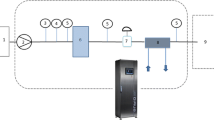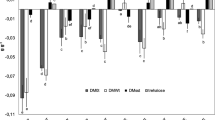Abstract
Several technological processes were applied to improve the extraction efficiency in the production of myrtle (Myrtus communis L.) liqueur. The variations in the chemical composition of myrtle hydroalcoholic extracts were monitored in a laboratory scale for 40 days after the application of: double dose of berries; ultrasonic extraction; enzymes, to improve either the color or aroma extraction; and atmosphere saturated with nitrogen to improve the stability against oxidative degradations during extraction. Moreover, freezing at −20 °C was applied to myrtle berries as a technological strategy to prolong the use of berries, and macerates were obtained after 4, 8, and 12 months. Chemical investigation of macerates was performed using different analytical methods such as GC and GC-MS for the volatile compounds, HPLC-PDA for free anthocyanins, and spectrophotometric analysis for CIE L*a*b* coordinates and total anthocyanins. Dry matter and pH were also monitored during maceration. Among the different technological processes, the nitrogen-modified atmosphere was the most suitable technique to be applied in industrial scale. An industrial trial was applied with this process and alcoholic extracts and liqueurs have been obtained. The liqueur maintained a higher amount of anthocyanins, better CIE L*a*b* parameters and superior organoleptic characteristics compared to the traditional storage.


Similar content being viewed by others
References
Lodi G (1986) Piante officinali Italiane. Edagricole, Bologna, pp 541–542
Atzei AD (2003) Le piante nella tradizione popolare della Sardegna. Carlo Delfino Editore, Sassari, pp 322–323
De Laurentis N, Rosato A, Gallo L, Leone L, Milillo MA (2005) Riv Ital EPPOS 39:3–8
Feisst C, Franke L, Appendino G, Werz O (2005) J Pharmacol Exp Ther 315:389–396
Nuvoli F, Spanu D (1996) Riv Ital EPPOS 12:231–236
Alamanni MC, Cossu M (2004) Ital J Food Sci 16:197–208
AA VV (1998) Caratterizzazione del liquore “Mirto di Sardegna Tradizionale”. Confindustria, Cagliari, Italy
Boulton R (2001) Am J Enol Vitic 52:67–87
Dao LT, Takeoka GR, Edwards RH, Berrios JDJ (1998) J Agric Food Chem 46:3564–3569
Garzón GA, Wrolstad RE (2001) Food Chem 75:185–196
Malien-Aubert C, Dangles O, Amiot MJ (2001) J Agric Food Chem 49:170–176
Rein MJ, Heinonen M (2004) J Agric Food Chem 52:3106–3114
Ribéreau-Gayon P, Glories Y, Maujean A, Dubourdieu D (2000) Handbook of enology, Vols 1 and 2. Wiley, Chichester
Franco MA, Versini G, Mattivi F, Dalla Serra A, Vacca V, Manca G (2002) J Comm Sci 41:143–267
Montoro P, Tuberoso CIG, Perrone A, Piacente S, Cabras P, Pizza C (2006) J Chromatogr A 1112:232–240
Montoro P, Tuberoso CIG, Piacente S, Perrone A, De Feo V, Cabras P, Pizza C (2006) J Pharmaceut Biomed 41:1614–1619
Mazza G (1983) J Chromatogr 264:304–311
Tuberoso CIG, Barra A, Angioni A, Sarritzu E, Pirisi FM (2006) J Agric Food Chem 54:1420–1426
Mulas M, Spano D, Biscaro S, Parpinello L (2000) Ind Delle Bevande 29:494–498
Tuberoso CIG, Melis M, Angioni A, Pala M, Cabras P (2007) Food Chem 101:806–811
Vacca V, Piga A, Del Caro A, Fenu PAM, Agabbio M (2003) Nahrung-Food 47:442–447
Acknowledgments
The authors offer their sincere thanks to Novozymes A/S for supplying the enzymes. Our thanks go to Zedda & Piras spa for supplying myrtle berries and for performing the industrial scale trials. This work was supported by a grant from the Italian Ministry of Instruction, University and Research (MIUR; project PON 12930).
Author information
Authors and Affiliations
Corresponding author
Rights and permissions
About this article
Cite this article
Tuberoso, C.I.G., Barra, A. & Cabras, P. Effect of different technological processes on the chemical composition of myrtle (Myrtus communis L.) alcoholic extracts. Eur Food Res Technol 226, 801–808 (2008). https://doi.org/10.1007/s00217-007-0596-x
Received:
Accepted:
Published:
Issue Date:
DOI: https://doi.org/10.1007/s00217-007-0596-x




